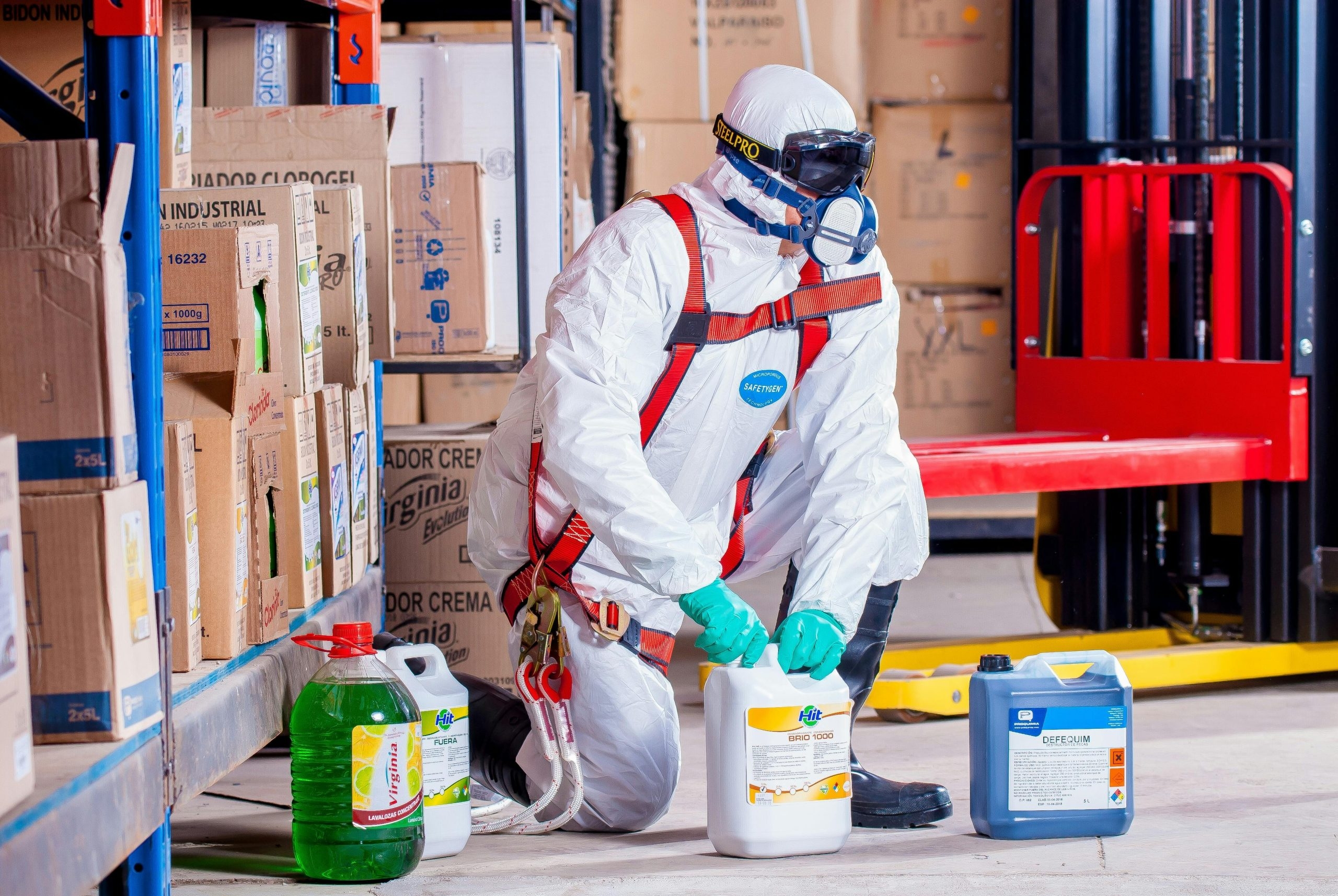Dichloromethane (DCM), also known by its chemical name methylene chloride, is a widely used solvent with a broad range of industrial applications, from paint stripping to pharmaceutical manufacturing. Despite its utility, DCM poses significant risks to health, safety and the environment, necessitating careful handling and adherence to stringent safety regulations.
This article explores the chemical properties, uses, and health risks associated with DCM, highlighting the importance of safety measures and regulatory compliance to minimise exposure and protect the health of workers. Understanding these factors is crucial for industries that rely on this volatile compound, ensuring they can continue to benefit from its use while mitigating potential hazards.
Chemical Properties and Industrial Uses of Dichloromethane
DCM is a colourless, volatile liquid with a mildly sweet odour and a low boiling point of around 39.6°C which facilitates its rapid evaporation at room temperature. It is slightly soluble in water but miscible with most organic solvents, this and its slight polarity enhance its effectiveness at dissolving a variety of organic compounds, making it a valuable solvent in many industries.
Paint Stripping: DCM has been used as the principal component of various paint and lacquer strippers due to its ability to effectively break down the chemical components. However, its use is now restricted in the EU and many such products now use benzyl alcohol as a safer alternative.
Chemical Synthesis: DCM’s unique chemical properties make it ideal for extracting active ingredients from raw materials and for purifying compounds during drug and chemical manufacturing processes. DCM's ability to effectively separate and refine chemical substances contributes significantly to the development of high-purity pharmaceuticals and the synthesis of complex chemical substances.
Metal Cleaning and Degreasing: DCM is widely used in the metal industry for cleaning and degreasing operations. Its powerful solvent properties make it exceptionally effective at dissolving oils, greases, and other contaminants from metal surfaces, which is crucial in preparing metals for processes like painting, coating, or further machining.
Aerosol Propellant: Historically, DCM has been used as an aerosol propellant in various spray products, ranging from paints to automotive products. Its effectiveness as a propellant comes from its high volatility, which allows it to quickly vaporise and disperse the contents of the can when sprayed. However, due to growing environmental and health concerns related to its toxicity and the potential for atmospheric degradation, the use of DCM in aerosol propellants has significantly decreased. Manufacturers are increasingly turning to safer, more environmentally friendly alternatives to meet regulatory standards and public health guidelines.
Plastics Manufacturing: In the plastics industry, DCM is primarily used for its solvent properties. It effectively softens and dissolves polymers, making it essential in the fabrication and welding of plastic components. DCM's ability to break down and manipulate plastic materials facilitates the creation of complex shapes and fine details in plastic products. This is particularly significant in the production of acrylic and polycarbonate plastics where precise and clean bonding is required.
Although widely used, the volatile and toxic nature of DCM, necessitates careful handling and adherence to strict safety standards to protect workers and the environment.
Routes of Exposure to Dichloromethane and Health Effects
Due to its high volatility, the most common route of exposure to DCM is via inhalation of its vapours which it gives off rapidly at room temperature. DCM vapour is colourless with a low odour so users may be unaware they are at serious risk. DCM can also be absorbed by the body via ingestion, dermal contact and injection.
The health hazards of DCM are various and impact multiple bodily systems. Once inhaled, DCM can quickly cause central nervous system depression, leading to immediate symptoms such as nausea, dizziness, and headaches. Prolonged exposure exacerbates these effects, potentially leading to severe neurological impairments such as memory loss and motor dysfunction.
The International Agency for Research on Cancer (IARC) has classified DCM as possibly carcinogenic to humans, noting evidence from animal studies but not conclusively from human data. Studies have shown that long-term exposure to DCM can cause liver and lung cancer in rodents, with mechanisms involving metabolic pathways that could potentially lead to similar effects in humans.
This carcinogenic potential is thought to be due to the metabolic conversion of DCM into carbon monoxide in the body, which can interfere with oxygen transport and utilization, as well as cause direct genetic damage over time.
Additionally, the chemical poses unique dangers to the cardiovascular system. There is a phenomenon known as "sudden sniffing death," which can occur when individuals are exposed to high concentrations of DCM, leading to fatal cardiac arrhythmias. This risk is exacerbated by physical activity immediately following exposure, which can increase heart rate and thereby the likelihood of a fatal arrhythmia.
DCM can cause a range of respiratory issues primarily due to its high volatility, which makes it easy to inhale. When inhaled, DCM vapours can irritate the respiratory tract leading to symptoms such as coughing, shortness of breath, and wheezing. In severe cases, prolonged exposure can lead to more significant respiratory distress and potentially damage lung tissue.
Dermal exposure to DCM can result in irritation, redness, and burns, particularly if the skin contact is prolonged. The solvent properties of DCM can also strip oils from the skin, leading to dryness and dermatitis.
Ingestion of DCM, which is less common, can be extremely harmful. If swallowed, DCM can cause burns to the mucous membranes of the mouth, throat, oesophagus, and stomach, leading to nausea, vomiting, abdominal pain, and in severe cases, it can lead to systemic toxicity affecting the central nervous system and other organs.
Injection of DCM into the body, an unlikely but potentially severe route of exposure, would introduce the solvent directly into the bloodstream, where it can quickly spread to organs and tissues. This can cause immediate and severe systemic effects including damage to the nervous system, liver, and kidneys, potentially leading to life-threatening conditions.
A Recent Case of DCM Injury
A recent case of DCM injection injury occurred when a student inadvertently injected a small amount of DCM (less than 2 drops) into his finger while setting up a chemical reaction. The incident led to severe consequences including necrosis and nerve damage in the affected area. The injury was treated with an emergency operation to remove necrotic tissue and save the finger, which otherwise might have needed amputation. Despite surgical intervention, the student experienced long-lasting effects, such as loss of sensation and altered functionality in the injured finger.
This case highlights the extreme risks associated with handling solvents like DCM, even in small quantities and underscores the importance of strict safety measures and immediate medical response in the event of such accidents.
DCM Risk Assessment
Under the Control of Substances Hazardous to Health Regulations 2002, employers are required to:
- Assess the risks that arise from the use of hazardous substances,
- Prevent, or if this is not reasonably practicable, control exposure to such substances,
- Provide staff with information, instruction and training about the risks and the precautions taken to control these risks.
The purpose of the risk assessment is to enable employers to make valid decisions about the measures needed to prevent or adequately control the exposure of their employees to hazardous substances arising from the work.
The below steps should followed when carrying out a risk assessment (commonly called a COSHH assessment) for DCM:
- Identify the Hazards: Review the material safety data sheet (MSDS) to understand DCM’s health risks, including its potential carcinogenicity, neurotoxicity, and effects on the respiratory system and skin.
- Assess the Risk: Decide who might be harmed and how.
- How is DCM stored and used, what are the work processes involved?
- What are the volumes and concentrations of DCM that are both stored and handled?
- How long are employees handling DCM for and how often does this occur?
- Who may be at risk, how many people and are there any particularly vulnerable individuals?
- What are the routes of exposure?
- Are there any workplace exposure limits to be complied with? The exposure limits for DCM are: 100 parts per million (ppm) over an 8-hour workday, or 200 ppm over a 15-minute period.
- What control measures are currently in place?
- Are the current control measures effective? Health Surveillance and Monitoring may be required.
- Control the Risk: Once the risk has been assessed, it is possible to identify and implement further control measures that will help to prevent exposure.
- Provide Information, Instruction and Training: When educating employees about the safe handling of Dichloromethane (DCM), it is essential to integrate comprehensive information, specific instructions, and practical training. Workers should be fully aware of DCM’s health hazards, including its carcinogenic potential and effects on the respiratory and nervous systems. Employers must ensure that everyone is familiar with the material safety data sheets (SDS) which detail DCM's properties, associated risks, and emergency response measures.
Practical instructions should include guidance on how to correctly handle, store, and dispose of DCM to prevent accidents. Training should cover the proper use of personal protective equipment (PPE), the execution of emergency procedures, and effective responses to spills. Additionally, routine refresher sessions and constant supervision help reinforce these practices and ensure that safety protocols are followed diligently.
- Monitor and Review: Monitoring and review are critical components of a COSHH assessment for DCM to ensure ongoing compliance and safety in the workplace. This involves regular checks to measure the effectiveness of existing controls and to identify any changes in the workplace that might introduce new risks.
Monitoring should include both the measurement of DCM levels in the workplace atmosphere and the health surveillance of workers exposed to DCM. Atmospheric monitoring might be done through personal or area air sampling to ensure that exposure levels remain below the legal limits. Health surveillance can include regular medical check-ups that focus on the respiratory system and neurological health, as these can be affected by DCM exposure.
The COSHH assessment should be reviewed regularly, at least annually or whenever there is a significant change in the work process or volume of DCM used. This review helps to determine if the risk management measures are still adequate or if new risks have emerged. It also assesses whether further improvements in control measures are feasible or necessary.
Controlling Exposure to Dichloromethane
The hierarchy of control is a system used to manage and minimise risks in the workplace. This approach prioritises control measures based on their effectiveness in reducing or eliminating hazards, such as exposure to DCM. The hierarchy of control is as follows:
Elimination: The most effective control measure is to eliminate the use of DCM altogether. This could involve changing work processes, methods or recipes to remove the need to use DCM.
Substitution: If elimination is not feasible, substituting DCM with a less toxic chemical can significantly reduce health risks. This step still addresses the hazard directly by using a safer alternative.
Engineering Controls: Implement engineering solutions to reduce exposure to DCM. This includes using closed systems for handling the solvent, improving ventilation systems, or using local exhaust ventilation at the source of DCM emission. Processes can be modified minimise the amount of DCM used or released into the workplace.
Administrative Controls: Implement safe work practices and procedures to reduce the duration and frequency of exposure to DCM. This could involve training workers on the proper handling of chemicals, providing clear operating procedures, and scheduling work to limit exposure.
Personal Protective Equipment (PPE): As the least preferred method, personal protective equipment should be used when other measures are not sufficient to control exposure. This includes wearing gloves, respirators, and protective clothing when handling DCM.
Dichloromethane is a useful but hazardous chemical requiring stringent controls to safeguard human health and the environment. Through regulatory compliance, proper safety training, and the implementation of effective exposure controls, the risks associated with DCM can be significantly mitigated, ensuring a safer workplace and a healthier environment.






